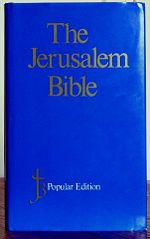Jerusalem Bible
2008/9 Schools Wikipedia Selection. Related subjects: Religious texts
| 'The Jerusalem Bible' | |
|---|---|
 |
|
| Full name: | The Jerusalem Bible |
| Abbreviation: | JB |
| Complete Bible published: | 1966 |
| Translation type: | Roman Catholic |
| Copyright status: | Copyright 1966 Darton, Longman & Todd |
| Genesis 1:1-3 | |
| In the beginning God created the heavens and the earth. Now the earth was a formless void, there was darkness over the deep, and God's spirit hovered over the water. God said, 'Let there be light', and there was light. | |
| John 3:16 | |
| Yes, God loved the world so much that he gave his only Son, so that everyone who believes in him may not be lost but may have eternal life. | |
| The Bible in English |
| Old English (pre-1066) |
| Middle English (1066-1500) |
| Early Modern English (1500-1800) |
| Modern Christian (1800-) |
| Modern Jewish (1853-) |
| Miscellaneous |
The Jerusalem Bible (JB) is a Catholic translation of the Bible which first was introduced to the English-speaking public in 1966 and published by Darton, Longman & Todd. As a Catholic Bible, it includes the deuterocanonical books along with the sixty-six others included in Protestant Bibles, as well as copious footnotes and introductions.
In 1943 Pope Pius XII issued an encyclical letter, Divino Afflante Spiritu, which encouraged Catholics to translate the Scriptures from the original Hebrew and Greek, rather than from Jerome's Latin Vulgate. As a result, a number of Dominicans and other scholars at the École Biblique in Jerusalem translated the scriptures into French. The product of these efforts was published as La Bible de Jérusalemin 1961.
This French translation served as the basis for an English translation in 1966, the Jerusalem Bible. For the majority of the books, the English translation was an original translation of the Hebrew and Greek; in passages with more than one interpretation, the French is generally followed. For a small number of Old Testament books, the first draft of the English translation was made directly from the French, and then the General Editor produced a revised draft by comparing this word-for-word to the original Hebrew or Aramaic. The footnotes and book introductions are almost literal translations from the French.
The translation itself uses a literal approach has been admired for its literary qualities, perhaps in part due to its most famous contributor, J.R.R. Tolkien (his primary contribution was the translation of Jonah).. The introductions, footnotes, and even the translation itself, reflect a modern scholarly approach, reflecting the conclusions of scholars who use historical-critical method. For example, the introduction and notes reject Moses's authorship of the Pentateuch.
The Jerusalem Bible was the first widely accepted Catholic English translation of the Bible since the Douay-Rheims Version of the 17th century. It carries the Church's imprimatur as being correct in all matters of faith and doctrine. This means it is an official Catholic Bible. The Jerusalem Bible was considered such a high quality advanced English translation of the Bible that the Holy See used it in the European liturgy and the Mass. This reference for The Jerusalem Bible can be found in the introduction page of the Roman Catholic Missals as the source reference for the readings. It has also been widely praised for an overall very high level of scholarship, and is widely admired and sometimes used by liberal and moderate Protestants. The overall text seems to have somewhat of a " Mid-Atlantic" nature, neither overwhelmingly British nor particularly American, making it acceptable to both groups in most instances. Overall, it has come to be considered as one of the better English translations of the Bible made in the 20th Century.
In 1973, the French translation received an update. A third French edition was produced in 1998.
In 1985, the English translation was completely updated. This new translation — known as the New Jerusalem Bible — was freshly translated from the original languages and not tied to any French translation (except indirectly, as it maintained many of the stylistic and interpretive choices of the French Jerusalem Bible).